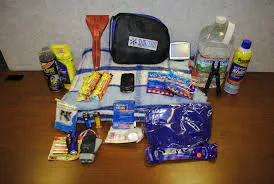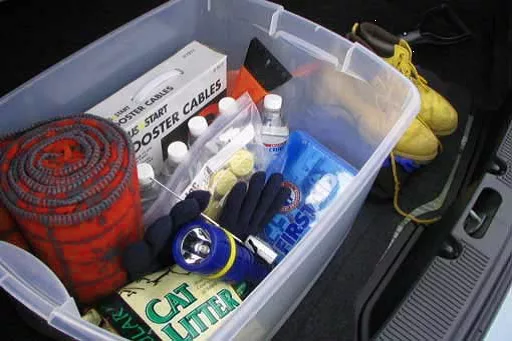Cold winter can change common places into big problems. For normal trips, a thin coat and soft gloves may be enough. But when going into snow or facing surprises, you need a stronger plan. This is when the winter survival kit becomes very important. It keeps you healthy and makes you feel strong enough to fight against the cold weather with bravery.
The Importance of Being Ready for Winter:
Winter’s pretty looks can trick us into thinking everything is okay. But under the pretty snow piles, there are hidden risks such as very cold weather, strong winds and dangerous ice. Also, there’s not much daytime where it’s bright enough to see clearly. Getting caught off guard in these situations can quickly change from a small problem to a big danger.
Mishaps happen, cars get stuck, power goes out and adventures in the wild can change suddenly. A good winter survival kit gives you the tools to deal with problems. It helps keep you warm, hydrated and able to talk until help comes. It’s your helper when bad times come, spending money for calm feelings that could be very important during cold weather.

Recognizing the Unique Challenges of Cold Weather
Unlike other seasons, winter has its own special challenges. It’s very important to know about these problems so you can make your survival kit the right way.
Hypothermia: The main worry in cold places is getting too cold, which can cause a dangerous situation called hypothermia. This happens when you lose heat quicker than your body can make it up. Getting wet, being out in the wind for a long time, and not having enough clothes can all lead to losing heat quickly.
Dehydration: Even though cold weather might lessen thirst, it’s still very important to stay hydrated. Cold air removes water from your body, and doing hard work in winter can quickly make you dehydrated. This affects how long you last and what decisions you make.
Reduced Visibility: Less light and winter storms often make it hard to see. Using these conditions needs good signaling things and the skill to create light.
Differentiating Between Everyday Winter Gear and a Comprehensive Survival Kit
Everyday winter clothes like coats and boots are okay for short trips or chores, but they can’t do what a real survival kit does.
Everyday Gear: Concentrates on simple comfort and safety for short periods in known places. Think of clothes that keep you warm, a hat, gloves and strong shoes.
Survival Kit: Made for long times in uncertain situations. It includes important things for finding your way, making a place to stay safe and warm, talking with others, helping hurt people and keeping yourself fed.
Keep watching for the next parts, where we’ll explore more about what you must have in your winter survival kit!
This is just the beginning part of the whole story. I will make big and complete parts for every other subject in the list. I will add important pictures and keep it simple with not too many words all packed together. Please tell me if you need any particular information or choices for the content.

Assessing Your Winter Environment: Adapting Your Kit to Nature’s Chill
Before getting ready your winter survival kit, think for a moment about the special place you’ll be in. Changing your kit to match the local weather, different seasons and possible dangers makes sure you’re ready for what might happen.
Tailoring Your Kit Based on Local Climate: Winter can make lots of landscapes, like snowy high mountains and towns near the sea with frequent rain. Consider these factors when building your kit:
• Mountainous Regions: Bring more insulation, things for getting grip like crampons and safety stuff against avalanches like beacons and tools to find people.
• Snowbelt Areas: Concentrate on boots that keep water out, snowshoes to help walk in snow and layers of clothes for dealing with windy or wet conditions.
• Coastal Regions: Put rain clothes, strong shoes for wet ground and protection from wind at the top.
• Arid Climates: Bring on lots of clothes for changing weather, something to protect from the sun and water supplies.
Considering Seasonal Changes and Temperature Variations:
Winter is not just a solid block of ice. The start and end of winter usually have less cold weather than the middle part. They can also be harder to deal with in some ways. Pack accordingly:
• Early Winter: Concentrate on rain clothes, wear layers of clothing and use emergency blankets for quick falls in temperature.
• Deep Winter: First, focus on getting warm clothes like thick coats, hot underclothes and protected outside layers for very cold weather.
• Late Winter: Bring things for cold places, like boots that keep you dry in wet mud and snow.
Conquering the Wilderness: A Guide to Essential Gear for Survivalists
Going into the wild is beautiful but it also has special sorts of problems. Having a place to sleep, staying warm and finding heat are very important for anyone who likes being outdoors. This might be for a weekend camping trip or something that lasts longer than two days. This big guide talks about important things you must take with you when going into nature. It ensures everyone will be happy and secure when they’re discovering.
The Essentials
Staying comfortable and secure in the outdoors starts with three fundamental elements: shelter, warmth, and heat. Learning these promises a fun and maybe life-saving trip.
Shelter and Warmth
Your house is your safe spot, a protecting shield against bad weather. Choosing the right one depends on several factors, including:
• Climate and Season: Consider the weather forecast and how hot or cold it will be. A little tent might be okay for summer holidays, but you need a tough one that works in all seasons for hard locations.
• Number of Occupants: Choose a tent that can fit all the people and their belongings. A small shelter may be uncomfortable and not good for feeling well.
• Ease of Setup: Pick a tent that is easy to set up, especially if you are by yourself or facing hard times.
Insulated Shelter Options:
• Tents: Free-standing tents are better because they give more options and shield from bad weather. Two-wall plans with padding keep warmth, perfect for chilly nights.
• Shelters: Tarps give you flexible cover. You can use them to quickly and easily build shelters or hanging beds. Consider the weight of the stuff and how good it keeps water out based on what you need.
• Hammocks: Floating shelters offer a good place to sleep, especially in wet or rough areas. Ensure your hammock has a rain cover and bug net to protect you from everything bad.
High-Quality Sleeping Bag Selection:
A good sleep bag is like your own personal nest. It helps your body stay warm so you can sleep good at night. Choose one based on:
• Temperature Rating: Pick a bag made for at least 10 degrees Fahrenheit colder than the expected low temperature. Pick a bag that fits like a mummy for its cozy warmth, or get a rectangle shaped bag if you need extra space to move around.
• Fill Material: Fake fillings don’t soak up water and are cheap, but natural fillings make you feel warmer for the same weight. However, they need extra care.
• Size and Comfort: Choose a bag that can easily fit your height and body size. Consider using a draft collar and a warm hood for extra heat.
Portable Heating Solutions:
Having a backup heat source for surprise weather or emergency situations is very important. Options include:
• Camping Stoves: Small and handy, stoves give heat while letting you make food. Pick a model that works with the type of fuel you like best (gas from a canister, liquid fuel and so on).
• Hand Warmers: Hand warmers that use chemicals or can be used again give warmth to hands and feet when needed. They are good for cold conditions.
• Space Blankets: These easy-to-carry, shiny sheets catch your body heat. They offer quick warmth and protection when needed during emergencies.
By choosing and using these important things properly, you’ll be ready to face the difficulties of nature. This will make your adventure comfy and safe.
Conclusion:
Having a nice winter kit can help you when facing winter issues. Put stuff in your bag for where you are now and spend cash to get nice things. Learn how to live better in cold areas. This will help you stay strong when it’s really cold outside. Remember, knowing and getting ready mean the same thing. Search for safe tips during winter, learn easy first aid techniques and practice with your survival gear before you use them.
FAQs
How often ought to I replace my wintry weather survival package?
Review your package annually and replace expired objects, replace clothing primarily based on seasonal modifications, and ensure batteries and electronics are useful.
What extra objects should I bear in mind for specific activities?
Backcountry snowboarding would possibly require avalanche safety gear, whilst ice fishing necessitates specialised garb and equipment. Research your specific hobby and adapt your package as a result.
Where ought to I save my wintry weather survival package?
Keep your kit without problems handy, preferably in a automobile trunk or backpack for outside activities. Consider storing a smaller kit, like a first-aid package and emergency blanket, in your property for winter weather emergencies.
What survival skills have to I learn?
Basic first resource, hearth beginning, safe haven building, and navigation are crucial competencies for wintry weather survival. Consider wasteland survival publications or on line sources to extend your understanding.
